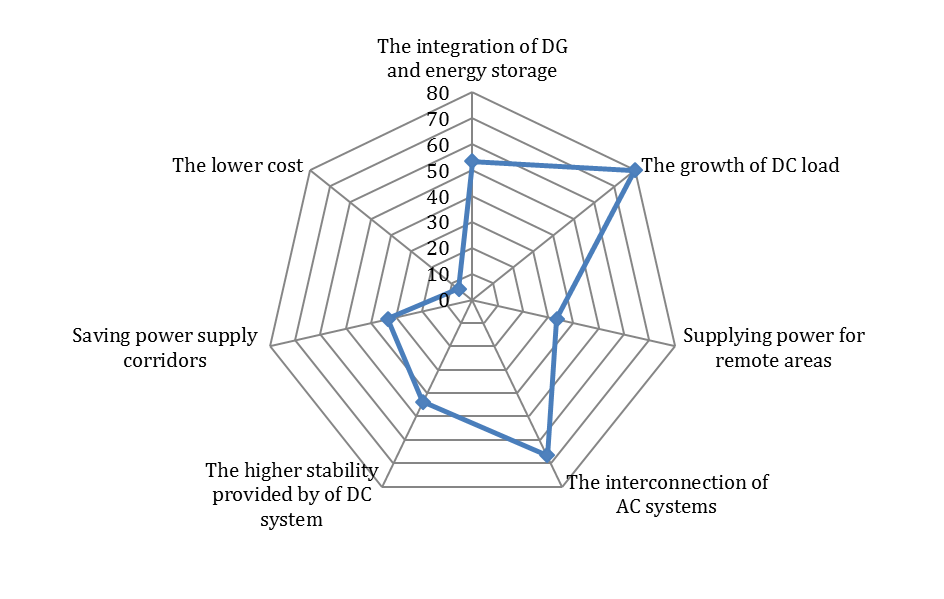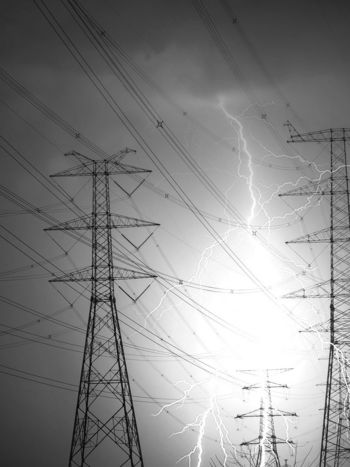Medium voltage direct current (MVDC) grid feasibility study
Medium Voltage Direct Current (MVDC) grids have been attracting global attentions as an expectative technology for power distribution system enhancement and modernization towards increased reliability, flexibility and efficiency. The objective of the working group is to evaluate existing and planned MVDC projects and research studies, identify potential system benefits and main technical challenges of MVDC technologies for different applications. The TB covers the following topics: global survey on the feasibility of MVDC grids; milestones and R&D status of MVDC technologies; motivation and operation of MVDC grids; technical requirements and features of MVDC grids; applications of MVDC grids.
Members
Convenor
(CN)
Z. MA
Secretary
(CN)
R Li
J. PAN (USA), P. LÜRKENS (DE), R. IRAVANI (CA), S.N. KIM (KR), D. DUJIC (CH), M. RIVA (IT), M. HAN (CN), R. DENIS (FR), B.W. LEE (KR), T. FUNABASHI (JP), W. YANAN (CN), C. BAE (KR), I. IYODA (JP), H. STOKMAN (NL), S. JUPE (GB), Z. MILETIC(AT), P. CARNE KJÆR (DK), C. CARTER-BROWN (ZA)
Reviewers : R.W. DE DONCKER (DE), I. IYODA (JP), H. STOKMAN (NL), T. FUNABASHI (JP), C. BAE (KR), Z. MILETIC (AT), C. CARTER-BROWN (ZA), S. JUPE (UK), P. CARNE KJÆR (DK)
Introduction
Due to the rapid development of Distributed Energy Resources (DERs), the high density urban proliferation, the fast growth of DC loads (such as LED lights, smart city, electrical vehicles and data/computer/telecommunication centres), and the increasing consumer’s demands for higher reliability and power quality, Medium Voltage Direct Current (MVDC) distribution grids have been significantly attracting global attentions. Although the research studies and technology demonstrations for HVDC transmission grids and LVDC micro grids have been greatly enhanced in the recent decade, the R&D activity of MVDC distribution grids is still in its infancy. Considering that the MVDC grids have different features and applications from HVDC grids and micro DC grids, a study on MVDC grids is necessary and in urgent need. CIGRE WG SC6.31 Medium Voltage Direct Current (MVDC) Grid Feasibility Study was set up in 2015 under this circumstance. In total, 35 domain experts and scholars from 14 countries have participated in the WG activities, representing electric utilities, academia, research institutes and manufacturers.
The scope of this WG was determined targeting MVDC distribution systems and applications with a voltage range between 1.5kV (±750V) up to 100kV (±50kV), which is the gap between CIGRE B4 HVDC and IEC SyC LVDC. The methodology followed by the Working Group was to first conduct a global survey on the driving forces and requirements of MVDC distribution grids and then perform detailed studies from the four aspects: MVDC project milestones and R&D status, motivations of developing MVDC grids and coordinated development of MVDC and MVAC distribution systems, technical requirements and operation features of MVDC grids, and promising applications of MVDC technologies. The present technical brochure is a summary of the collaborative work of the WG Members.
Global survey on needs of MVDC grids
A global survey was conducted by the WG. From the survey feedbacks (Figure 1), it found that the main driving forces for the development of DC power distribution are the growth of DER and DC loads, and the interconnection of AC systems. The considered MVDC distribution voltage range is 1.5kV~100kV and the preferred voltage level sequence is 100kV--±50kV--35kV--±10kV-1.5kV. The MVDC distribution may have various configurations such as back-to-back or point-to-point DC links, radial or double ended DC feeders, and multi-terminal DC systems for different application scenarios. Protection hardware, including DC circuit breakers and DC fuses, needs to be developed. High efficiency power converters, including AC/DC converters for connecting MVAC distribution networks and DC/DC converters for connecting LVDC distribution networks or DC loads, are critical equipment. The development of DC distribution network should be integral part of utility distribution expansion process. The vision is to gradually build a harmonious and efficient hybrid AC-DC distribution network.

Figure 1 - Driving forces for the development of DC power distribution
Milestones and R&D status of MVDC grids
Existing projects and studies concerning medium voltage DC utility-like grids are represented in this WG report. The basic properties of developed or planned MVDC projects are illustrated. For the present study, publicly available information was considered up to early 2018. The following list the published major finished and recently undergoing MVDC projects and research status as a milestone.
- 1997 Hällsjön-Grängesberg, Sweden: +/-10kV/3 MW MVDC-Link
- 2000 Tjaereborg, Denmark: +/-9kV/7.2 MW MVDC-Link
- 2003 Siemens SIPLINK product
- 2014 Foundation of FEN Research Campus (for LV and MV DC Grids)
- 2014 Network Equilibrium: Back-to-back 33kV/20 MVA MVDC-Link
- 2015 University of Nottingham: 6 Terminal 5 kV/6x1MW lab facility
- 2015 Scottish Enterprise - MVDC Technology Study - Market Opportunities and Economic Impacts
- 2015-2018 ETG Study “Direct Current in the Electrical Power Distribution”
- 2015 Start of project “DC-Direkt”
- 2015-2018 CIGRE Study “Medium Voltage Direct Current (MVDC) Grid Feasibility Study”
- 2016 Start of project “Angle DC”
- 2017 Siemens announcement of MVDC-utility-technology on product level (“MVDC plus”)
Motivation and operation of MVDC grids
Characteristics, configurations, expansion and operation constraints of MVAC distribution networks and the potential benefits provided by MVDC distribution for different applications are studied in this report. In addition, the impacts of MVDC grids on MVAC distribution networks are discussed with focus on fault detection and isolation, grounding, power quality and stability issues. The need of coordinate development of MVAV and MVDC distribution networks is then discussed in the report highlighting the need of the standardized DC voltage levels.
Technical requirements and features of MVDC grids
In general, for medium voltage DC distribution, the voltage level should be determined to match or exceed the power delivery capacity of corresponding medium voltage AC distribution network; for low-voltage DC distribution, the voltage level should match the voltage level of DC loads. The feasible DC voltage ranges and preferred voltage level sequences are recommended with consideration of AC network connection constraints, insulation constraints and desired power supply capabilities. Different MVDC grid topologies and associated features are discussed including radial topology, ring topology and mesh topology as well as different operating configurations. It is envisioned that MVDC distribution system will be configured for interconnection with MVAC grids and LVDC grids (Figure 2), and the AC system and the DC system will operate together and support each other in near future.

Figure 2 - Existing grid structure (left) and near future grid structure (right)
The study further analyses the power supply capability of MVDC circuits. The study results show that the power supply capability of MVDC circuits is 1.63 times of the corresponding MVAC circuits which having similar installation and conductor cross section. Study results of power quality and efficiency are also in favor of MVDC power distribution. The report also provides MVDC grid integration strategies for renewable energies such as wind and PV, the strategies for the operation and control of the DC grids, the DC fault analysis and protection etc. The report gives a general review of the main challenges mentioned above and the status quo of development. The topology and operating principle of DC circuit breakers, DC fault current limiters and DC/DC converters are reviewed. The concept of distributed autonomous control is explained. The inter-polar and pole-to-ground short circuit current behavior under different grounding configurations is analyzed and protection strategies are suggested.
Applications of MVDC grids
MVDC distribution grids are expected to play a major role in future electric energy systems. The existing and promising near future applications include MVDC electrified railway systems, MVDC power distribution in urban load areas, MVDC collection grid of renewable power plants, MVDC power distribution on large ships, and DC electrification of industrial plants and buildings.
Conclusions
MVDC grids have great advantages in renewable energy access, DC load power supply and other aspects over AC grids, and attract the interest of many international scholars. Therefore, MVDC grid is the expectative technology for power distribution system enhancement and modernization towards increased reliability, flexibility and efficiency, but the research on MVDC girds is still in its infancy. There are still some technical challenges and difficulties that need to be addressed through continued research activities and detailed studies. The following are the main conclusions of the MVDC Grid Feasibility Study Working Group:
- MVAC grid and MVDC grid will be in coexistence for significant time in future power distribution systems. The system benefits of implementing MVDC grids vary for different applications. For utility distribution system applications, the main benefits are high power supply capability of DC circuits, power flow control flexibility and allowing higher penetration of DERs, while the main benefits for industrial electrification and renewable integration are reduced investments and/or increased efficiency.
- Fundamentals and key technologies for MVDC grids require continued detailed and in-depth study. In particular, further studies will include recommended and standardized DC distribution voltages, network topology and configuration, methods and simulation tools for planning DC distribution systems or hybrid AC-DC distribution systems, development of cost-effective power conversion and protection devices, system earthing issues etc.
- There is the need to stimulate technological breakthroughs in new semiconductor materials, advanced application of information science and AI technology in DC distribution system or hybrid AC-DC distribution system, and large-scale demonstrators of MVDC technologies in utility and industrial distribution systems and connection of renewables.
- In spite of some existing projects of MVDC grids, the technologies for MVDC grids are project based, there is no unified, credible MVDC related standards yet. So it is suggested to develop a series of standards for MVDC grids.






